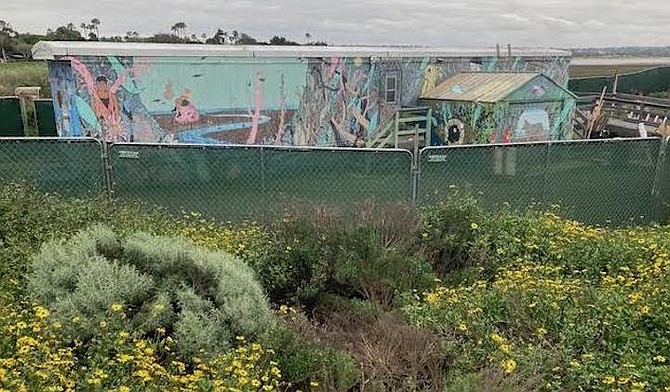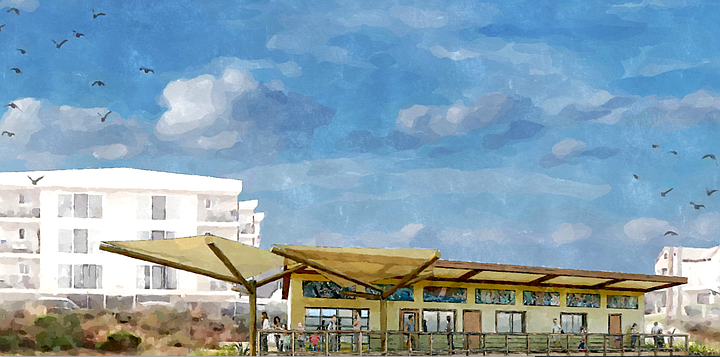 Facebook
Facebook
 X
X
 Instagram
Instagram
 TikTok
TikTok
 Youtube
Youtube

Work has begun on a new field station and learning center at the Kendall-Frost Marsh Reserve that by year’s end will provide a more spacious and modern facility for academic researchers, K-12 students and community groups on a northern corner of Mission Bay.
The 1,400-square foot modular building will replace a decrepit trailer that served the same purpose for more than half a century.
The reserve is within the last 40 acres of what once was a vast expanse of marshland in the area. The land was donated to UC San Diego in the 1950s and later incorporated into the UC Natural Reserve System – a statewide network of 41 ecological reserves managed by the University of California for education, research and public service. UCSD began a $1.7 million fundraising campaign in 2019 to pay for the trailer’s The trailer had provided limited laboratory space, not only for UCSD scientists but also researchers from as far away as Idaho and Wisconsin. It has long served as an indoor-outdoor classroom for Mission Bay High School students. The trailer could no longer accommodate so many uses.

The new building will feature a laboratory, storage space and basic overnight accommodations for a couple of researchers on its north side. The south end will feature a multipurpose room that can be used for community meetings and events, and classes. It will open out to an observation deck. Each side of the building will have its own entrance.
“The two parts of the building can be used independently, which is very different than what it is now where everybody is falling over each other,” said Heather Henter, executive director of the UCSD Natural Reserve System. “We have researchers staying there [currently] while we’re having a big public outreach event. It’s really been kind of awkward.”
While the community room and deck may seem an appealing venue for your sister’s wedding or your father’s birthday bash, it will be restricted to groups engaged in marshland-related activities. That could be, for example, a gathering of nature photographers or artists, or an environmental group meeting.
Salt marshes such as Kendall-Frost are prime habitat for carbon sequestration, which helps mitigate the impacts of climate change. Ongoing research there is measuring this and may be useful in managing the anticipated expansion of wetlands to the immediate east.
UCSD researchers also are “putting a dollar value on ecosystem services at Kendall-Frost Marsh,” Henter said, whether it is in mitigating the future costs from sea level rise and storm surge to increasing nearby home values and property tax revenues.
More than 500 people visit Kendall-Frost one day every February for tours and exhibits at “Love Your Wetlands Day.”
During construction, “Wander the Wetlands” activities conducted from 9-11 a.m. on the second and fourth Saturday every month will be relocated from the trailer to the dirt parking lot at the north end of Crown Point Park.
While nobody will miss the ramshackle trailer that squatted on Kendall-Frost, the mural that adorned it is loved by many. Photo recreations of some of the fauna and flora and significant Kendall-Frost figures depicted in it will be included on the exterior of the new building.
The fate of the mural’s 4-by-8-foot metal panels is uncertain. “We’re hoping to find a new home for them,” Henter said.


Work has begun on a new field station and learning center at the Kendall-Frost Marsh Reserve that by year’s end will provide a more spacious and modern facility for academic researchers, K-12 students and community groups on a northern corner of Mission Bay.
The 1,400-square foot modular building will replace a decrepit trailer that served the same purpose for more than half a century.
The reserve is within the last 40 acres of what once was a vast expanse of marshland in the area. The land was donated to UC San Diego in the 1950s and later incorporated into the UC Natural Reserve System – a statewide network of 41 ecological reserves managed by the University of California for education, research and public service. UCSD began a $1.7 million fundraising campaign in 2019 to pay for the trailer’s The trailer had provided limited laboratory space, not only for UCSD scientists but also researchers from as far away as Idaho and Wisconsin. It has long served as an indoor-outdoor classroom for Mission Bay High School students. The trailer could no longer accommodate so many uses.

The new building will feature a laboratory, storage space and basic overnight accommodations for a couple of researchers on its north side. The south end will feature a multipurpose room that can be used for community meetings and events, and classes. It will open out to an observation deck. Each side of the building will have its own entrance.
“The two parts of the building can be used independently, which is very different than what it is now where everybody is falling over each other,” said Heather Henter, executive director of the UCSD Natural Reserve System. “We have researchers staying there [currently] while we’re having a big public outreach event. It’s really been kind of awkward.”
While the community room and deck may seem an appealing venue for your sister’s wedding or your father’s birthday bash, it will be restricted to groups engaged in marshland-related activities. That could be, for example, a gathering of nature photographers or artists, or an environmental group meeting.
Salt marshes such as Kendall-Frost are prime habitat for carbon sequestration, which helps mitigate the impacts of climate change. Ongoing research there is measuring this and may be useful in managing the anticipated expansion of wetlands to the immediate east.
UCSD researchers also are “putting a dollar value on ecosystem services at Kendall-Frost Marsh,” Henter said, whether it is in mitigating the future costs from sea level rise and storm surge to increasing nearby home values and property tax revenues.
More than 500 people visit Kendall-Frost one day every February for tours and exhibits at “Love Your Wetlands Day.”
During construction, “Wander the Wetlands” activities conducted from 9-11 a.m. on the second and fourth Saturday every month will be relocated from the trailer to the dirt parking lot at the north end of Crown Point Park.
While nobody will miss the ramshackle trailer that squatted on Kendall-Frost, the mural that adorned it is loved by many. Photo recreations of some of the fauna and flora and significant Kendall-Frost figures depicted in it will be included on the exterior of the new building.
The fate of the mural’s 4-by-8-foot metal panels is uncertain. “We’re hoping to find a new home for them,” Henter said.
Comments